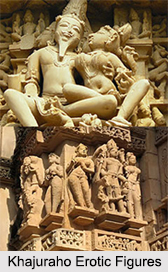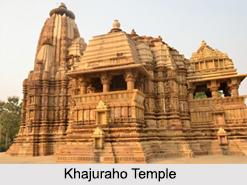 Khajuraho Erotic Figures at the Khajuraho Temples represent love and lust in various forms. There seems to be different interpretations regarding the erotic sculptures of Khajuraho- from stories to spiritual beliefs. Khajuraho temples do not contain erotic art near the deities. External carvings bear erotic art.
Khajuraho Erotic Figures at the Khajuraho Temples represent love and lust in various forms. There seems to be different interpretations regarding the erotic sculptures of Khajuraho- from stories to spiritual beliefs. Khajuraho temples do not contain erotic art near the deities. External carvings bear erotic art.
The external curvature and carvings of the temples depict humans, human bodies and the changes that occur in bodies. Some contain sexual themes and the rest depict the regular life of the common Indian people. It shows women putting on makeup, musicians, potters, farmers and many more. The mundane scenes are depicted at some distance from the temple deities.
History of Khajuraho Erotic Figures
Erotic motifs were considered alankara, protective and auspicious in Kandarya Mahadeva function. Thus, many temples in India built between AD 900-1300 blatantly display erotic themes and Khajuraho is one of such sites. Erotic figures first appear at Khajuraho in AD 950, on the Lakshmana temple, the earliest temple built in the elite Nagara style of architecture dedicated to Lord Vishnu.
 Interpretations of Khajuraho Erotic Figures
Interpretations of Khajuraho Erotic Figures
The erotic carvings in Khajuraho Temple have been interpreted differently. These carvings depict the physical as well as the cosmic union of man and woman. It also portrays that in order to see the deity, one must leave his or her sexual desires outside the temple. It also shows that divinity is pure like the atman, which is not affected by sexual desires. Some say that they were designed to test the spiritual strength of the Yogis.
Apart from sculptures that portray the Kama (desire), the temple also has figures that illustrate the other three fundamental goals of life - Dharma (duty), Artha (means of livelihood or wealth) and Moksha (liberation).
Position of Khajuraho Erotic Figures
At Khajuraho, the architects assign erotic motifs to the following places: the door-jamb of the sanctum; the narathara or human activities row of the plinth; the row of the jagati or platform along with royal pastimes, battle scenes and dancers; the recesses of the jangha; and niches of the superstructure. Couples are also placed round the images of Sapta Matrikas (Mothers) in the two Shiva temples, the Vishvanatha and the Kandariya Mahadeva. There are some temples that have two layers of walls which have small erotic carvings on the outside of the inner wall.
The erotic sculptures have been placed on the wall portion between the two balconies in the three major Hindu sandhara temples. This wall portion is actually the juncture of the big hall and the sanctum. There are two head-down postures on the juncture walls of the two Shiva temples in the Western group. Their composition is remarkably similar to the Kamakala Yantra of the architectural text Shilpa Prakasha. The beauty of young maidens is appreciated in the sensuous carvings of apsaras and surasundaris on temple walls.



















